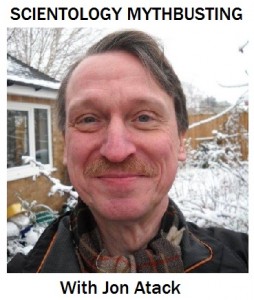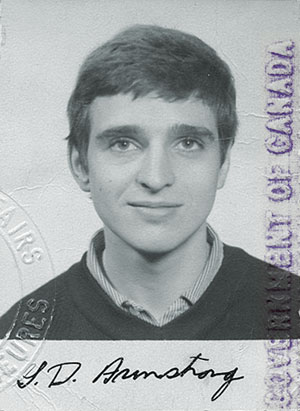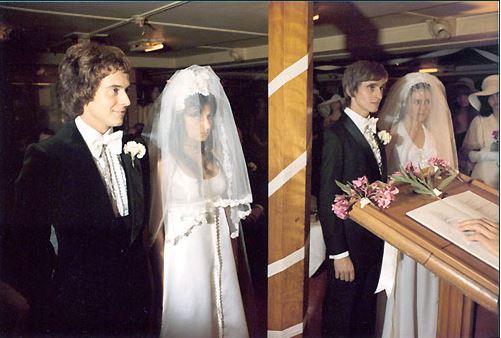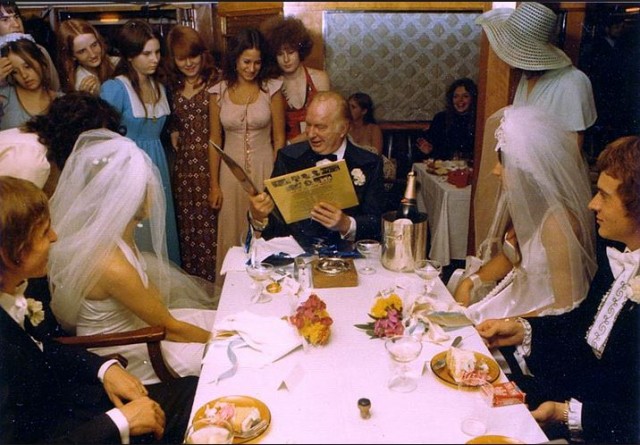The Church of Scientology may be around for years to come, but it’s in such dire straits at the moment, we can’t help thinking about some of the consequences if it suddenly went belly up. One of the first things that comes to our mind are the many people whose lives are affected negatively on an ongoing basis because of the church’s legacy of ripped apart families, onerous legal settlements, and silencing gag orders. One of the first people we’d like to see sprung from years of legendary harassment, for example, is British Columbia resident Gerry Armstrong, who avoids stepping foot in the United States because of a legal history that is almost too outlandish to believe.
It’s also a very complex history, and that’s why we’ve turned to Jon Atack for help. This week, we begin a series on Gerry Armstrong and his legal plight that we hope will eventually, perhaps, lead to some real changes to make up for an incredible legacy of shameful behavior against a man who simply tried to tell the truth.
Jon, to start out, can you tell us about the first time you met Gerry?
JON: In May 1984, I was asked to help out with a case which was going before Justice Latey in the High Court, in London. Two children had been left in the custody of their father, because a Scientology Chaplain’s Court had resolved that he was the better Scientologist and so the better parent. A couple of years down the line, escaped from the cult’s clutches, the mother and her new husband put together a truly remarkable case. Justice Latey would later rule in open court (unheard of in family cases in England), giving a 54-page ruling about the evil nature of Scientology, which he called “corrupt, immoral, and sinister.” Gerry had agreed to testify and we met a few days before the case opened.
It was a memorable day for me. I’d spent six months gathering whatever evidence I could, and interviewing anyone who would talk to me. Armstrong held the key to the famous Hubbard Archive. The mountain of information he’d collected — which ran into the hundreds of thousands of pages — had convinced him that Scientology founder L. Ron Hubbard was an out and out, unregenerate fabulist. During that first meeting, the phone rang and Boston attorney Michael Flynn filled Gerry in on the details of Judge Paul Breckenridge’s decision in his favour in the groundbreaking California trial.
 That day, Gerry told me about a letter from Hubbard to his third wife, Mary Sue, where he talked about drinking rum and taking “pinks and greys” (which may well have been the drug Darvon, according to Gerry’s later research). The idea that Hubbard had been a drug user was utterly foreign to me, as a recovering Scientologist. Gerry also told me that Hubbard had taken phenobarbital.
That day, Gerry told me about a letter from Hubbard to his third wife, Mary Sue, where he talked about drinking rum and taking “pinks and greys” (which may well have been the drug Darvon, according to Gerry’s later research). The idea that Hubbard had been a drug user was utterly foreign to me, as a recovering Scientologist. Gerry also told me that Hubbard had taken phenobarbital.
I’d left the Tech a few months before, but I was still chary of showing OT III to the uninitiated. As it happened, I had shown a copy of the pack to a friend who’d left the church after doing OT II. He wanted to know if he should do OT III with the independents — or buy a Ducati motorcycle. I had no qualms about showing him the material, because he was ready for it, even in Scientology’s terms. I came back from my meeting with Gerry, and told my friend that Hubbard had been “on drugs” when he wrote OT III. He handed me the pack, and said, “Phenobarbital.” I had to do a double take, but he explained that as a young man, he’d taken this powerful barbiturate and that in high doses, it had made him feel that the world was exploding and that he had been fractured into separate entities. Later, of course, I saw the prescription for phenobarbital in Hubbard’s Navy records — for his purported ulcer — and found his own admission, in a lecture, that he’d been addicted to that barbiturate (the original Research and Discovery series, volume 1, at page 124). Of course, Hubbard had been talking publicly about “entities” as far back as 1952, and privately with his own guru, Arthur J Burks, long before that (they called them “the little its”), but the explosions were new, and the date of the “incident” coincides with the discovery of a great extinction, which was later redated by scientists.
I arranged one other meeting before Gerry flew back to the US, but we were hijacked by three former Sea Org execs — all of whom were declared Suppressive, and all of whom thought that Gerry was working for the FBI. I was charmed by the friendly way in which Gerry dealt with their obvious aggression. When asked if he believed in the state of Clear, Gerry smiled and said that he’d yet to meet one. My most important memory of that meeting was a comment Gerry made about a “scale” he’d found in Hubbard’s papers, which placed the Fool at the top — the illumined sage, unperturbed by suffering and above the world — and “fanatics and zealots” below the Fool, acting as a sort of trampoline. This was a profound insight into the Tech behind the Tech — Hubbard’s intention was to create a band of followers (I call them Dev-OTs) who would follow his will without question. He believed that he could become a sort of god through this means.
THE BUNKER: That year, 1984, was a remarkable one for Scientology history. But let’s now go back to the beginning; Gerry grew up in Chilliwack, British Columbia and was introduced to Scientology at 22 by a friend in 1969. He began attending courses at the org in Vancouver, and then in 1971 went to Los Angeles to sign up with the Sea Org.
JON: Gerry joined the flagship Apollo, from which L. Ron Hubbard, as “Commodore,” ran Scientology from a small armada of ships that plied the Mediterranean, Atlantic, and Caribbean from 1966 to 1975. Gerry was the port captain, so he became familiar with the invention of “shore stories” — cover stories to throw off the locals about what Scientology was really up to. In 1974 he was married on the yacht to Terri Gilham, a member of a famous Scientology dynasty (and stepdaughter of Heber Jentzsch) and Pat Broeker married Trudy Venter in a double ceremony…
THE BUNKER: That’s Pat and Trudy on the left, and Gerry and Terri on the right.
And the Commodore looked like he had a whale of a time…
The next year, the Apollo finally stopped its wanderings and Scientology invaded Florida, eventually taking over the town of Clearwater. But Hubbard had to keep moving to stay ahead of process servers, particularly after the FBI raided the church in Los Angeles and Washington DC in 1977 over Operation Snow White, Scientology’s infiltration of government offices. By 1979 Armstrong was part of a Household Unit that was preparing a house for Hubbard to move into at the Gilman Hot Springs property, near Hemet, California. And that’s when one of Armstrong’s juniors stumbled upon a collection of boxes.
JON: It was over twenty boxes of material that had followed Hubbard in his travels — from the US to England — and it seems likely that no one had ever leafed through their contents. In this treasure trove were Hubbard’s baby booties, his teenage journals, his hypnotic “Affirmations” or “Admissions,” and the magic ceremonies that immediately preceded the creation of Dianetics and Scientology. Gerry saved them from the shredder, and on January 8, 1980, he requested permission to start a biographical archive. Permission was granted, and, because Hubbard went into deep hiding at this time, he was unavailable to rescind the order. Gerry even managed to requisition a car and traveled around interviewing key Hubbard supporters. He was also in touch with many early supporters, including Don Rogers, whose appendices were still printed in Dianetics: The Modern Science of Mental Health into the 1980s, and who gave me the title of my book.
Armstrong was devastated by what he found in Hubbard’s documents. The cult’s appointed biographer, Dan Sherman, tells us that this material shows that Hubbard was a real life Indiana Jones. What Armstrong discovered was a real life Walter Mitty, a Baron Munchausen, a Billy Liar. When the movie Dive Bomber was about to be shown, because Hubbard claimed to have written it, Armstrong was able to show that this was not the case: Hubbard had written a few scripts for the movie serial The Secret of Treasure Island, but had no major Hollywood credits. Worse yet, Armstrong found that Hubbard’s claims to being a war hero were entirely fabricated. Hubbard’s “war wound” was a fall down a ship’s ladder. His only active service was a 55-hour battle against a magnetic deposit off the coast of Oregon, followed by shelling a Mexican island, after which he was removed from command.
Armstrong took his concerns to his bosses, only to be accused of treason. When no one would listen, and he was being threatened with punitive action, Gerry fled, and the then official biographer, Omar Garrison, gave him copies of some of the more damning material. Judge Breckenridge cleared Gerry of any “theft” of documents.
The cult continues to claim that Gerry “stole” this material, and even the august New Yorker wrongly accused me of using “stolen materials” because of this claim. The truth is that the cult failed in its claim of “conversion” — or theft — before Breckenridge, because of the dire circumstances created by the cult. Judge Breckenridge ruled that Armstrong was within his rights to deliver the documents to his attorney, to protect himself from the very real possibility of harm under the Fair Game doctrine. Gerry also wanted to protect the truth of Hubbard’s life, well aware that this material would otherwise disappear down the memory hole. As Judge Breckenridge said: “He believed that the only way he could be sure that the documents would remain secure for his future use was to send them to his attorneys, and that to protect himself, he had to go public so as to minimize the risk that LRH, the Church, or any of their agents would do him physical harm.”
Instead, in typical mad dog mode, Scientology’s ruling clique subjected Gerry to a full-scale attack. At one point, there was even an attempt — which is recorded in the Breckenridge decision — to run Gerry off the road, which could have resulted in his death.
THE BUNKER: As you put it in Blue Sky: “The myth of L. Ron Hubbard was badly fractured. It seemed that his mesmeric hold over Scientologists, whether Church members or Independents, was slipping. The trance could only be maintained through a stubborn refusal to consider the material now available.”
JON: If the cult had left Gerry alone, it is very possible that the debacle of the early 1980s, during which time about half of the membership left — would not have happened.
THE BUNKER: And as we’ll see, Scientology’s mad dog mode was only beginning for Gerry Armstrong.
——————–
Links of Note
If you haven’t seen them yet, a couple of nice articles published yesterday sum up the Leah Remini situation so far — Dana Kennedy at The Hollywood Reporter suggests that Leah may be worried about the church culling her confidential auditing files for damaging information in a retaliation campaign. And Hollie McKay has an interesting piece at FoxNews.com which includes some interesting prognosticating by public relations experts about how they expect the church to deal with the disastrous press fallout continuing after Remini’s defection became known.
On the odder side, there’s a weird piece about Dennis Erlich at VICE and an even weirder one about Lawrence Wollersheim at Forbes. We’re gathering some information for a longer look at the Forbes piece in a few days.
Oh, and one more thing. Coming Thursday: PZ!
——————–
Posted by Tony Ortega on August 3, 2013 at 07:00
E-mail your tips and story ideas to tonyo94@gmail.com or follow us on Twitter. We post behind-the-scenes updates at our Facebook author page. Here at the Bunker we try to have a post up every morning at 7 AM Eastern (Noon GMT), and on some days we post an afternoon story at around 2 PM. After every new story we send out an alert to our e-mail list and our FB page.
If you’d like to help support The Underground Bunker, please e-mail our webmaster Scott Pilutik at BunkerFund@tonyortega.org









